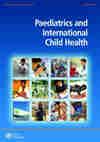坦桑尼亚北部住院儿童肌肉骨骼疾病的范围和负担
IF 1.4
4区 医学
Q3 PEDIATRICS
引用次数: 1
摘要
肌肉骨骼疾病(MSD)是造成全球疾病和残疾负担的一个主要因素,对低收入和中等收入国家的影响尤为严重;然而,缺乏流行病学数据。受影响的儿童往往面临更高的发病率、社会孤立和经济困难。目的评估坦桑尼亚一家主要转诊医院收治的5-18岁儿童MSD的范围和负担。方法本研究是一项回顾性队列研究,研究对象为乞力马扎罗山基督教医疗中心(KCMC)收治的5-18岁儿童,这些儿童在2017年1月1日至12月31日期间被国际疾病分类-10确认为肌肉骨骼疾病。结果2017年,KCMC收治了163例确诊的儿科MSD,占5-18岁儿童入院总数的21.2% (n = 769)。骨病是最常见的诊断。其中外伤性骨折106例(65.0%),骨关节感染31例(19.0%),畸形愈合9例(5.5%),病理性骨折3例(1.8%)。先天性缺陷和风湿病相对少见,分别仅占6例(3.7%)和4例(2.5%)。结论MSD以骨折为主,其次为骨关节感染,风湿病少见。这项研究虽然规模不大,但确定了坦桑尼亚一家医院在12个月期间收治的儿科MSD的相当大的负担和范围,并强调需要进行更大规模的研究,以便为卫生资源的最佳分配提供信息。缩写CI:置信区间;高收入国家:高收入国家;艾滋病毒:人类免疫缺陷病毒;ICD-10:国际疾病分类;IQR:四分位间距;JIA:幼年特发性关节炎;KCMC:乞力马扎罗山基督教医疗中心;中低收入国家:低收入和中等收入国家;MSD:肌肉骨骼疾病;NAI:非意外伤害;NIHR:国家卫生研究所;非洲抗风湿病联盟儿科学会;RTA:道路交通事故;SCD:镰状细胞病;SLE:系统性红斑狼疮;SSA:撒哈拉以南非洲。本文章由计算机程序翻译,如有差异,请以英文原文为准。
The spectrum and burden of in-patient paediatric musculoskeletal diseases in Northern Tanzania
ABSTRACT Background Musculoskeletal diseases (MSD) are a major contributor to the global burden of disease and disability, and disproportionally affect low- and middle-income countries; however, there is a dearth of epidemiological data. Affected children often face increased morbidity, social isolation and economic hardship. Aim To assess the spectrum and burden of paediatric MSD in children aged 5–18 years admitted to a major referral hospital in Tanzania. Methods This was a retrospective cohort study of children aged 5–18 years admitted to Kilimanjaro Christian Medical Centre (KCMC) whose initial diagnosis was recognised as a musculoskeletal condition by the International Classification of Diseases-10 between 1 January and 31 December 2017. Results During 2017, 163 cases of confirmed paediatric MSD were admitted to KCMC, representing 21.2% of all admissions of children aged 5–18 years (n = 769). Bone disease was the most common diagnosis. They comprised 106 (65.0%) traumatic fractures, 31 (19.0%) osteo-articular infections, 9 (5.5%) malunions and 3 (1.8%) pathological fractures. Congenital defects and rheumatic disease were relatively uncommon, accounting for only 6 (3.7%) and 4 (2.5%) MSD admissions, respectively. Conclusion The majority of cases of MSD were related to fractures, followed by osteo-articular infections, while recognised cases of rheumatic disease were rare. The study, although small, identified the sizeable burden and spectrum of paediatric MSD admitted to a hospital in Tanzania over a 12-month period and highlights the need for larger studies to inform the optimal allocation of health resources. Abbreviation CI: confidence interval; HIC: high-income countries; HIV: human immunodeficiency virus; ICD-10: International Classification of Diseases 10; IQR: interquartile range; JIA: juvenile idiopathic arthritis; KCMC: Kilimanjaro Christian Medical Centre; LMIC: low- and middle-income countries; MSD: musculoskeletal diseases: NAI: non-accidental injury; NIHR: National Institute for Health Research; PAFLAR: Paediatric Society of the African League Against Rheumatism; RTA: road traffic accidents; SCD: sickle cell disease; SLE: systemic lupus erythematosus; SSA: sub-Saharan Africa.
求助全文
通过发布文献求助,成功后即可免费获取论文全文。
去求助
来源期刊

Paediatrics and International Child Health
PEDIATRICS-
CiteScore
3.30
自引率
0.00%
发文量
19
审稿时长
6-12 weeks
期刊介绍:
Paediatrics and International Child Health is an international forum for all aspects of paediatrics and child health in developing and low-income countries. The international, peer-reviewed papers cover a wide range of diseases in childhood and examine the social and cultural settings in which they occur. Although the main aim is to enable authors in developing and low-income countries to publish internationally, it also accepts relevant papers from industrialised countries. The journal is a key publication for all with an interest in paediatric health in low-resource settings.
 求助内容:
求助内容: 应助结果提醒方式:
应助结果提醒方式:


